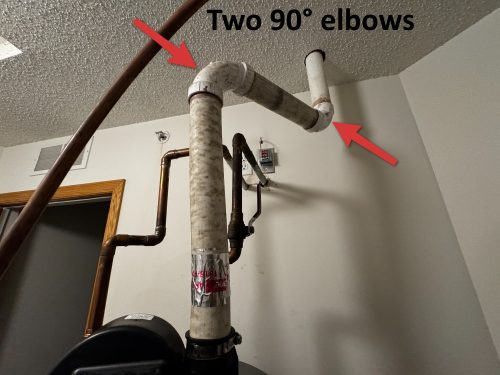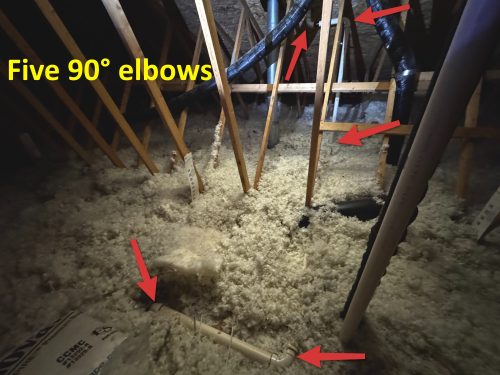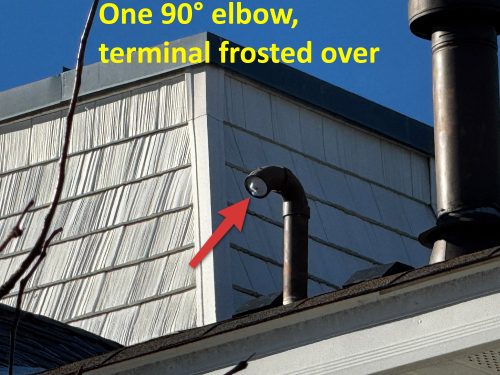A powervent water heater uses a fan to get the exhaust gases out of the home. They’re great because there’s almost zero possibility of backdrafting, a common problem with natural draft water heaters. Most powervent water heaters use a 3-inch PVC pipe to get the exhaust gas out of the home, but sometimes we find a 2-inch pipe. In those cases, it’s a good idea for any home inspector to pay a little closer attention to the installation.
Troubleshooting inspection
We recently conducted a troubleshooting inspection for a condo association to solve a water heater problem. One of the homeowners continually had his water heater stop working during when it got very cold outside. He had a few different contractors out to fix the issue, and they were never able to figure out the issue. Exasperated, he hired us to use a camera to inspect the interior of the vent, because the latest contractor suggested he might have a hidden obstruction in the vent.
But that wasn’t the problem.
The problem was that water heater vent was improperly installed from day one. The installer used a 2-inch PVC pipe to get from the ground-level utility room, all the way up through the middle of the two-story building, through the attic, and then out through the roof. Here’s what the venting looked like:
There are two elbows in the utility room.
The vent runs straight up for two stories, and then takes five more turns in the attic.
Then it discharges through the roof, where you have one more elbow, along with a 45° terminal fitting.
Also, you’ll notice the terminal is completely covered with frost.
The manufacturer allows a total vent run of 55 feet if using a 2-inch pipe. For every 90°, you must subtract 5 feet from the calculation. With the 8 elbows pictured, we need to subtract 40 feet. That means you’re left with a maximum run of 15 feet of pipe. I can see way more than 15 feet of pipe in the attic alone without measuring.
This would have been perfectly fine if the installer had used a 3-inch pipe for the vent. The manufacturer allows up to 155 feet of venting with that size pipe, which is more than I’ve ever seen in any home. The water heater is shutting off because the vent is too small; it can’t get the exhaust gases out of the house with all those elbows and all that pipe.
The fix will likely require replacement of the vent or possibly some creative work with the fittings to reduce the number of elbows and a lot of that excess piping in the attic.
Conclusion
It’s perfectly fine to use a 2-inch pipe on a water heater vent, but home inspectors should pay closer attention to these installations. The overall length of the vent and the number of elbows should never exceed the maximum listed by the manufacturer. Any home inspector reporting on this kind of thing is certainly going beyond the minimums required by their standard of practice, but that doesn’t mean they should ignore this stuff when they see it.
Whenever I come across a 2-inch pipe on a powervent water heater, I pay a little more attention to these details, and I’m quick to look up the installation instructions. When 3-inch pipes are used, there’s never an issue with this stuff.




Nick Welty
February 11, 2025, 9:12 am
Hey Ruben, my team really enjoys watching your informational videos and the delivery you give relaxed and dynamic for all listeners, whether inspector’s, homeowners or tradies.
I don’t know if your team test thermal expansion tank air, but probably five years ago we started testing and it has been astonishing that 99% of tanks we inspect only have the pre-charge of 35 to 45 psi rendering them useless or worse they’re full of water and leaking at the Schrader valve because of it. I believe the number one cause for leaking hot water tank is unregulated pressure and thermal expansion. I have been trying to educate the builders and plumbers In Kansas City to no avail.
Many inspectors I know do not understand how they work and plumbers as well.
Scott J. Zeiger
February 26, 2025, 9:56 am
Good information as usual. Thank you